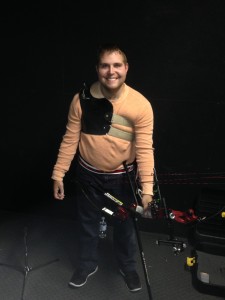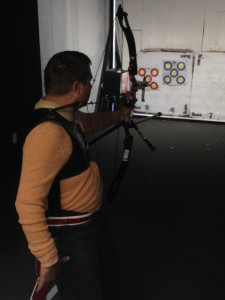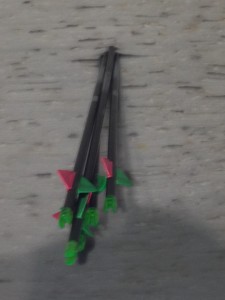The Critical Doer Attacks Problems And Creates Opportunities From The Inside Out
I’ve shared with you before that I enjoy archery. Any day on the archery range is a good day…today was exceptional.
I went to one of my favorite archery spots today…The Sportsman’s Outpost in Waverly, Alabama…to get in a few shots. When I walked into the indoor range, I met an extraordinary young man named Justin Strafuss.
Justin is from Collierville, TN (near Memphis)…he’s in town visiting his brother who is a senior at Auburn University. Here’s what I learned in a few minutes about Justin…he was born with cerebral palsy, he has a college degree in graphic design, he is a championship archer training to qualify for the United States Paralympic Archery Team, and by golly he is a critical doer!
As you know, archery is traditionally a sport that requires 2 arms and hands for holding the bow and releasing the string. That’s not possible for Justin…but look at this picture and see how he thought through the physical limitation and traditional way of doing things to still become an accomplished archer.
Justin is able to use his left arm for holding the bow, aiming, and pulling the string. He uses a shoulder harness with a release that he activates with his chin to release the string. If you’re wondering how good he is, take a look at this grouping:
Any archer…absolutely any archer…would be proud for this picture to be their shot grouping. But archery isn’t the only place where Justin had to find alternative solutions for a problem. Take a look at his YouTube video that shows how he uses one hand to tie his shoes…this video has been viewed over 10,000 times and when you see it you’ll understand why his parents say “Can’t is not in Justin’s vocabulary.”
Justin is a great example of how a critical doer attacks problems from the inside out. It’s easy to fall victim to “binary thinking” where the only solutions are the traditional way or no way. By focusing on what needs to be done rather than what can’t be done, we can be like Justin and find innovative ways to accomplish things far beyond what conventional wisdom would deem possible. That’s why I’m confident Justin will qualify for the team and represent our nation one day in the Paralympics…a grand celebration through sport of the unconquerable human spirit.
Justin’s example leaves us with this challenge…is there a problem where you are frustrated and feeling defeated because the usual solutions aren’t working? If that’s the case, follow this pattern of thought and action: (1) shift your focus from circumstances to the desired end state (2) mentally commit to opening your mind to new solutions (3) develop plans for new solutions and determine an order for trying them (4) start doing and continue doing, regardless of failures and difficulties, until you’ve accomplished your objective. It’s what a critical doer would…do!
You can follow Justin’s story on Facebook and Twitter. If you’re looking for a great sport that blends physical and mental challenges consistent with critical doer philosophy as well as putting you in contact with awesome people like Justin, consider a trip to your local archery shop and get started.
Reminder: you can get automatic updates from The Critical Doer by using the subscription widget at the bottom of this post. You can also follow on Facebook, Twitter, and Google+. I also encourage you to let me know what you think of the posts or share a story of your own using the comments section or email me directly at [email protected].



Awesome story in its own right.
“If you’re looking for a sport …”
True, the beauty of archery as a sport is that it can be a lifetime sport. There are some challenges in moving from the recreational archer level into being competitive at higher levels.
And it is precisely those challenges that offer the opportunity for archers to really think critically and then to act critically to raise the level of their game and then to do something with their finely tuned skill sets.
Factors (not in priority order) that apply inside and outside archery:
1. Humility. Can you figure it out on your own? If not, how do you find and then select a coach or mentor? Are you willing to accept the idea that someone else may have an idea that conflicts with how you would have thought about the issue? Are you willing to have an attitude of “Ok, I’ve done my homework and made my mind up. Convince me I’m wrong.” And then be genuinely engaged with the possibility that you were wrong.
2. Energy. Do you have the energy to make the move from where you are to where you want to be?
3. Analysis and willingness to experiment. Are you making progress through intermediate goals? Are you willing to experiment and accept that the results of the experiment indicate that your hypothesis was wrong? By the same token, are you willing to increase effort along lines of experimentation that show promise — while recognizing that you can get “too much of a good thing”? Are you willing to make small tweaks and then methodically measure the results of that tweak?
4. Balance. Is your search/endeavor to improve creating an unacceptable opportunity cost for you? Are you tuned into the feedback signals that tell you that you’ve gone past a healthy approach into obsession?
5. Planning and goal setting. Are you setting appropriate goals — specific, measurable, attainable? Are you willing or able to create a plan to link your efforts to sub-goals that drive to an overall big goal?
6. Vision. How far can you see? What happens after you attain your overall goal? Game over? Lost a driving purpose in your life / organization? Can what you learn transfer into other areas of your life or to new endeavors? If so, then how, and what adaptations must you make to do so?
7. Tenacity. Are you willing to meet defeat (setbacks) with the same enthusiasm as successes? Which do you really learn more from — that which didn’t work out or that which did? “Courage isn’t always a lion’s roar. It’s sometimes the heart at the end of the day saying, ‘I will try again tomorrow!'”
8. Free thinker. Are you bound by the conventional wisdom that says, “It ‘must be’ done this way.”? Or are you willing to think outside the box to develop something new or different?
9. Comprehensive approach.
True, archery is a sport dependent in part on equipment. If the equipment doesn’t function consistently the same — the archer can not improve. Some equipment choices require a higher level of perfection from the archer. Other choices are more forgiving and tolerant of minor execution errors. Some equipment choices will naturally result in lower or higher scores than others. For example, archers competing at long range typically use heavy, skinny arrows with low profile fletching to minimize wind drift issues. Light fat arrows with large fletching will drift more — requiring the archer to offset aim. But how much? Can the archer consistently aim at some indeterminate point off target as well as he could at a definite point on the target?
But archery is also a physical sport requiring the exact same execution form shot to shot to reach high levels of performance. Draw weights can range over 70 pounds. NASP archers may be competing with bows having draw weights as low as 10 pounds. Some organizations limit the bow’s draw weight to 60 pounds and others to 80 pounds. Recurve and long bows increase their draw weight for every bit of draw length. Compound bows typically have a percentage of let-off that reduce the holding weight to 15 to 50% of the bow’s peak draw weight. The mass weight of the bow can range from about 3 or 4 pounds to about 10 pounds (all held at full extended arm length). Competitions can range from 12 shots to well over 100 shots. Competitions can also range from a few minutes to hours or even multiple days.
Archery is also a mental sport. The mental discipline to focus on what you need to and disregard everything else when you need to is crucial. The mental discipline to not accept mediocrity anytime during shot execution and choose to not shoot the shot is also crucial. The mental toughness to deal with pressure doesn’t just happen. Individuals must develop those skills through practice and experience.
To be successful, an archer’s approach must be comprehensive and encompass all three of these areas — equipment preparation, physical preparation, and mental preparation. The salient question remains — what are the pillars that must be included in the pursuit of your goals?